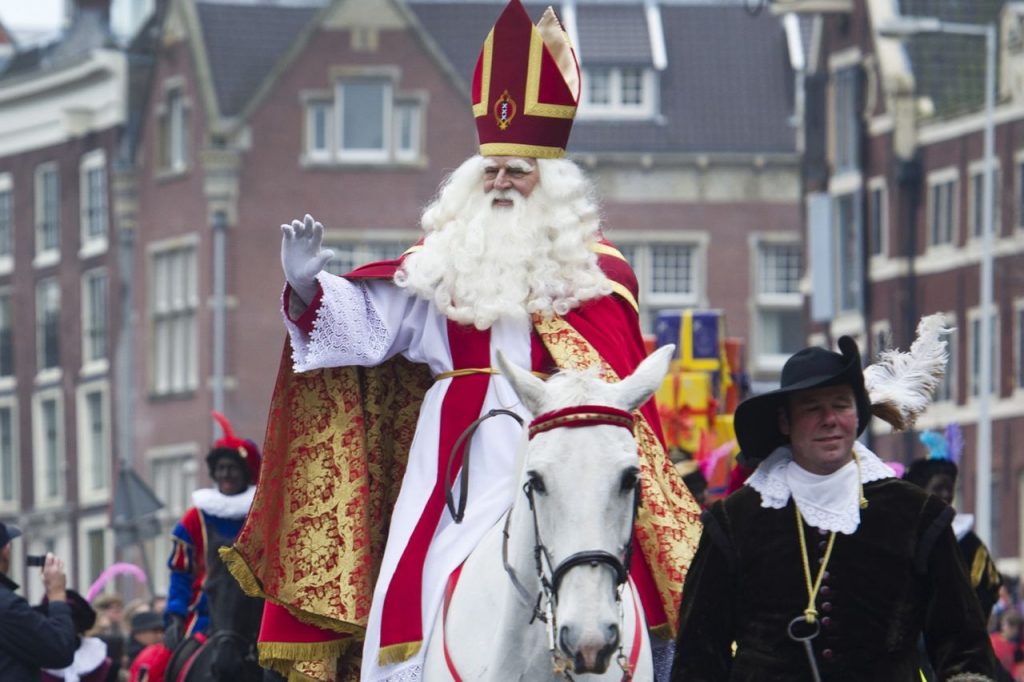by Kelly R. Smith

|
This article was updated on 12/09/20.
Ads we feature have been independently selected and reviewed. If you make a purchase using the links included, we may earn commission, which helps support the site.

Judging by the two images above, Santa Claus and Sinterklaas look remarkably similar. They have the same copious hair and whiskers, the same predominately red and white garment color scheme, and a jovial spirit. But, that’s where the similarities begin to diverge. But whichever fellow you are talking about, the mystique has evolved into one of our favorite holidays.
The Origins and History of Santa Claus
Some say that the original Santa Claus was Saint Nicholas who was the Bishop of Myra, a small Roman town in modern Turkey in Anatolia. This was around 270 AD. He had a reputation for secretly giving gifts to those in need.
Although his suit is red today, it was originally green. His marital status has changed; Santa was a bachelor until around 1849 when a wife (Mrs Claus) was mentioned in the short story, ‘A Christmas Legend’ written by James Rees. Many tales followed this book, including ‘The Legend of the Christmas Tree.’
What about that jolly face? How accurate is our portrayal to the real St. Nick of yesteryear? The short answer is that it may be very close. Why? It is believed by some scholars that St. Nicholas’ bones were absconded by Italian sailors during the 11th century and taken to the crypt of the Basilica di San Nicola located on the southeast coast of Italy. The crypt was repaired in the 1950s and the Nick’s skull and bones were documented with x-ray photos and thousands of detailed measurements. From there, scientists used modern forensic facial reconstruction to give us the image we know and love today.
But where did the tradition of giving Christmas gifts to children begin? We have two stories to illustrate this. The first one is better known and goes like this: three young girls are saved from a life of prostitution when the young Bishop Nicholas quietly delivers three bags of gold to their indebted father, which he can use for their dowries. The second tale relates that St. Nicholas entered an inn whose keeper had just crudely murdered three boys and pickled their dismembered bodies in basement barrels. The bishop not only sensed the crime, but resurrected the victims as well. Hence, he became the patron saint of children.
In the 1500s the Protestant Reformation began and good old St. Nick fell out of favor across northern Europe. But in the Netherlands, kids and families would not give up St. Nicholas as a gift bringer. (And, who can blame them?) And that’s when they brought Sinterklaas with them to New World colonies.
The Origins and History of Sinterklaas
Sinterklaas (his name is a contraction of Sint Nikolaas, in case any of you linguists were wondering) is based on jolly old St. Nick but cast in a Dutch mold. He looks similar in that he is a jolly old sod dressed in red but he sports a bishop’s hat, rides a white horse, and carries a long, curled shepherd’s staff. An important distinction is that the Dutch conceptualize him as a kindly old man instead of a Catholic saint. The end result is that Sinterklaas is celebrated by Dutch people of all ages and beliefs, without any real religious connotations.
The rituals surrounding Sinterklass and Santa differ as well. The Feast of Sinterklaas is held on December 6th, the day that St. Nick passed away. This is when gifts are exchanged and good-natured fun is made of loved ones. Christmas is focused on family and church services, not gift-giving.
The Sinterklass-Santa Connection
The general consensus is that Sinterklaas was the precursor of our Santa Claus tradition. Many historians hold that Dutch and German settlers carried the tradition with them when they went to America. There, his Catholic garb was bit by bit morphed into the jolly non-sectarian red suit with the white fur trim we are all familiar with. Also, his lithe frame gave way to a well-padded potbelly, and his trusty white horse was traded in for a troupe of reindeer. Either way, both Sinterklaas and Santa Claus stand for the generosity of spirit and kindness to children.
Others are Reading:
- Columbus Day: History and Controversy
- Is Scientology a Cult or a Religion?
- Who Was St. Patrick and Why Was His Holiday Invented in America?
- Who Was Halloween’s Jack-o’-Lantern?
- Rosh Hashanah; the Jewish New Year
- Top New Year’s Resolution Ideas and the Path to Success

Looking for more great content? Visit our main site I Can Fix Up My Home or our partner sites:
I offer article and blog-writing services. Interested? Contact me for a quote!
Did you find this article helpful? Millions of readers rely on information on this blog and our main site to stay informed and find meaningful solutions. Please chip in as little as $3 to keep this site free for all.
Visit Kelly’s profile on Pinterest.
About the Author:
 Kelly R. Smith is an Air Force veteran and was a commercial carpenter for 20 years before returning to night school at the University of Houston where he earned a Bachelor’s Degree in Computer Science. After working at NASA for a few years, he went on to develop software for the transportation and financial and energy trading industries. He has been writing, in one capacity or another, since he could hold a pencil. As a freelance writer now, he specializes in producing articles and blog content for a variety of clients. His personal blog is at I Can Fix Up My Home Blog where he muses on many different topics.
Kelly R. Smith is an Air Force veteran and was a commercial carpenter for 20 years before returning to night school at the University of Houston where he earned a Bachelor’s Degree in Computer Science. After working at NASA for a few years, he went on to develop software for the transportation and financial and energy trading industries. He has been writing, in one capacity or another, since he could hold a pencil. As a freelance writer now, he specializes in producing articles and blog content for a variety of clients. His personal blog is at I Can Fix Up My Home Blog where he muses on many different topics.



